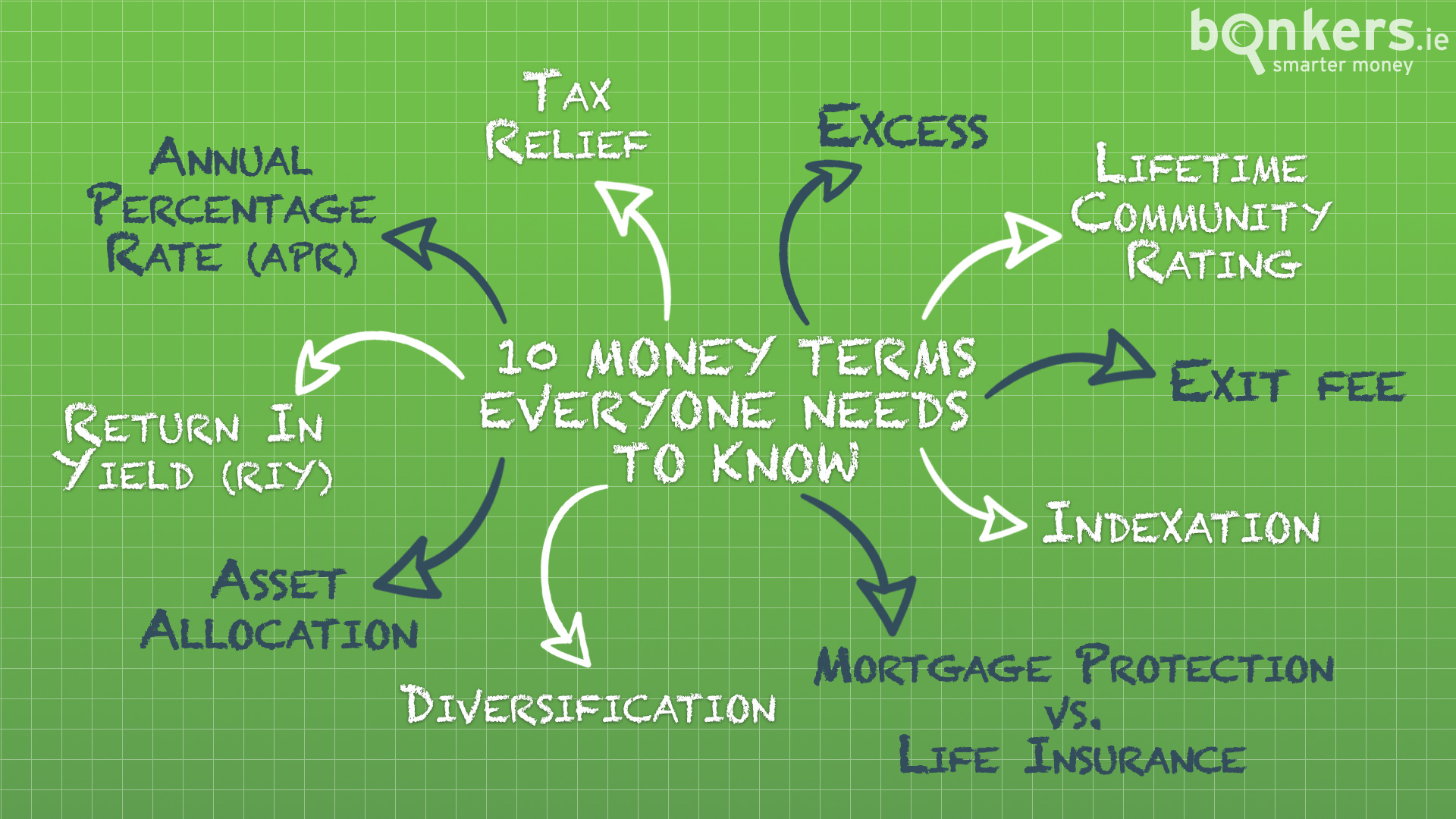
At bonkers.ie we’re all about smarter money and one of the first steps towards getting better at managing your finances is to know what some of those important money terms and definitions actually mean!
Money matters and personal finance aren’t always the most exciting of topics, but they're important nonetheless.
It’s surprising then how few of us know how to manage our money effectively or who properly understand the most important financial terms.
Here we give you the lowdown on 10 important money terms that everyone needs to know.
1. APR
APR stands for Annual Percentage Rate. It’s often confused with interest rate even though they are two different things.
Your interest rate is the cost you’ll pay to borrow money. The rate can be either fixed (meaning it doesn't change) or variable (meaning it could go up or down) and it's always expressed as a percentage. Your interest rate only includes the interest you’ll be charged for borrowing money and doesn’t include any other fees you might be required to pay.
The APR of a loan is the cost of interest PLUS any other fees which are added to your loan. For a mortgage, for example, this could include things like admin fees, insurance costs or broker fees. For this reason APR is used to provide a broader and more accurate indication of the true cost of a loan over its lifetime and the rate will almost always be higher than the interest rate you see quoted.
Also, unlike interest rates, you can use the APR to properly compare different loans to see which offers better value, as long as you compare them over the same time period. For example a five-year loan with an APR of 3.5% will cost you less than one with a 3.7% APR. However a 15-year loan with an interest rate of 3% could actually end up cheaper over the full term than a loan with an interest rate of 2.8% depending on what other fees and charges are included.
2. Reduction in yield (RIY)
Reduction in yield - or RIY - is a way of showing the impact that the charges on a savings, investment or pension policy will have over a period of time. It outlines the reduction in the return that would otherwise have been achieved if the policy carried no charges at all.
Basically, the higher the RIY, the more charges you’re paying.
Sometimes policies can carry lots of different types of fees and charges so simply comparing one charge, such as the fund management fee, isn’t always enough to determine which policy will charge you the least. As a result, reduction in yield is an excellent way to judge which policies are good value for your savings or pension.
As savings, investment and pension policy policies can typically run for many years, the fees and charges can really add up. You’d be shocked to see how much of your pension savings could get eaten up by charges, which is why it’s important to know the RIY.
Under law all disclosure notices, which you get before before taking out a savings, investment or pension policy, must show the projected reduction in yield so be sure to review it carefully!
3. Asset allocation
This is where you chose to to put your money.
There are four major asset classes: stocks, bonds, property and cash. Each asset class reacts differently to conditions in the economy, and some are more volatile than others, so when saving be sure to choose the assets that best match your own financial goals and attitude towards risk.
For example, investing in stocks could give you strong returns over the medium to long term, but they can also be quite volatile in the short run. Bonds on the other hand tend to have a lower, but more stable, rate of return. Some assets like stocks can be relatively quick and easy to buy and sell, whereas other assets like property take far longer.
As a result, one of the most common pieces of investment advice is to diversify your savings, which bring us on to our next point...
4. Diversification
Diversification is a type of investment strategy. It means not investing everything you have in one place or putting all your eggs in the one basket.
For example, if you put all your money in one single stock, or even in several different stocks that are all in the technology sector, you're not diversified.
At its heart diversification is all about reducing risk. You can diversify by asset class e.g. bonds, property, and shares; by region e.g. Europe, America and Asia; and by industry e.g. technology, finance, and construction.
Remember back in 2008/9 when so many people lost all their savings in Anglo Irish and AIB shares? Well that’s because they weren’t diversified - had they spread their money over more types of shares, assets and regions they’d have lost a lot less!
A well diversified investment might have a mix of European and American technology and banking shares, Irish and European government and corporate bonds, and commercial and residential property.
Obviously it’ll be too costly for the average person to invest in all these assets separately, which is why people usually invest in managed funds through life assurance companies, where money is pooled from many entities and then invested generally in a broad range of assets by the fund manager.
5. Mortgage protection vs life insurance
Mortgage protection is usually compulsory for all mortgage holders in Ireland, though there can be exceptions.
Mortgage protection differs from life insurance in that the amount you’re insured for reduces each year to broadly match what’s left on your mortgage whereas with life insurance, or term insurance, the amount stays the same for the term of the policy, or maybe even increases if you’ve chosen indexation (for an explanation on that see our next point). For this reason, life insurance is usually more expensive than mortgage protection.

6. Indexation
Indexation is a strategy that aims to adjust payments to try keep up with inflation.
Indexation can apply to lots of things such as pension payments, wages, insurance premiums and tax bands.
For example, if you take out life insurance over 10 years for €100,000, you might choose the indexation option, let’s say 5%. This means that your level of cover (but also your premium) will increase by 5% each year to help keep up with inflation.
This means if you were to die in year five of your policy, almost €130,000 would be paid out, not the original €100,000.
7. Exit fee / Early repayment fee
This is also known as an early encashment or exit charge.
It’s a charge applied by a financial institution or bank when you cash in an investment before a specific date or pay back a loan in full before it was due to end. Not all banks and financial institutions charge an exit fee/early repayment fee but many do.
If you have a short-term savings goal in mind, investing in a policy with this type of charge may not be for you. Your policy’s terms and conditions will outline what the fee might be.
8. Lifetime Community Rating
If you’re in your 30s and haven’t taken out health insurance yet then this is something you need to know about.
The Irish private health insurance market is what's called ‘community rated’. This means everyone pays the same amount for the same level of cover regardless of their age, sex or health. But this can only work if there are lots of younger, healthier people buying insurance too.
Under Lifetime Community Rating, if you’re over the age of 34, a 2% loading will apply to your premium for every year you don’t have private health insurance. So under this system, a 40-year-old who purchases insurance for the first time today will have a 12% loading applied to their policy but a 40-year-old who has had insurance since he or she was 33 won't.
Basically, if you don't want a loading to apply to your policy, take out health insurance before you hit 35 or as soon after as possible.
9. Excess
This is the first part of any insurance claim that you have to pay for yourself. It can apply to all types of insurance like health insurance, car insurance and home insurance.
Sometimes you can choose the level of excess that applies to your policy, in which case the higher the level of excess that you choose, the lower your premium will be.
For instance, if the excess under your policy is €250, and you’re making a claim for €4,000, the insurance settlement that you receive will be €3,750.
Before making a claim it’s important to know what the excess will be as there may be no point making a small claim for €300 or €400, and thereby losing your no claims discount, if an excess of €300 or more applies to your policy.
10. Tax relief
Fancy pay less tax? Then get comfortable with the concept of tax relief and how it might apply to you.
Tax relief reduces the amount of tax you pay and can apply to a whole host of different payments such as pension payments, work expenses, certain tuitition fees (apart from the registration fee), and health and dental expenses that aren't covered under any private health insurance you might have.
If you're a PAYE taxpayer and are saving into an approved pension plan then the tax relief will be applied at source (meaning you'll pay no income tax on the amount you're putting into your pension). Other reliefs usually need to be claimed but this can all be done quickly and easily on Revenue's online system.
There's a four-year limit to how far back you can claim tax refunds. For example, claims for 2014 must be made by 31 December 2018. Claims made after this time cannot be repaid.
Every year millions of euro go unclaimed so make sure you apply for any relief you might be due! Check out Revenue's website for more information.
Switch with bonkers.ie today
Now that you're up to speed with some of the most important money terms, check out the rest of our site for ways to compare prices and save money on your bills.
It's easy. It's free. It's bonkers.ie!


%20(3).jpg)
.jpg)
